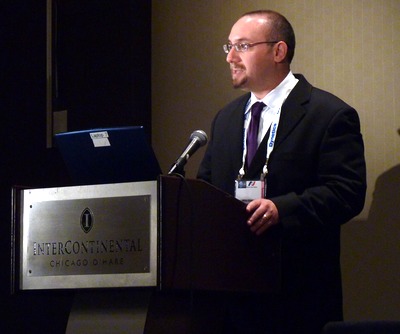
Mike Gold talks about Bigelow Aerospace's plans at the ISDC in Chicago on Friday.
Mike Gold, director of Washington operations for Bigelow Aerospace, spent much of his 45-minute speech at the International Space Development Conference (ISDC) in Chicago talking about the history of Bigelow’s development of inflatable (or, as the company prefers, “expandable”) modules, including the successful launch of Genesis I and II in 2006 and 2007, respectively; familiar ground for most who have followed the company. He also discussed the company’s future plans, including how NASA’s proposed new direction in human spaceflight may directly and indirectly affect the company.
Bigelow’s plans to launch a series of larger habitable modules, starting with the 180-cubic-meter Sundancer, are dependent on the introduction of commercial crew transportation services, a key element of that plan. “The long pole in the tent for our operations is that while we could have Sundancer ready very quickly, we don’t have a way to get people back and forth,” he said. Without it, the company’s investment “will be for naught”. He believes that commercial crew services will be as safe, if not safer, than government systems, as companies have a lot more riding on the line than a government agency: while NASA could (and has) survived fatal accidents in the past, a company could lose hundreds of millions of dollars or go our of business entirely in such an event. “We’re more incentivized to be safe than a government agency because we have a lot more riding on it.”
However, Bigelow is a bit particular about who they work with on commercial crew. “We love SpaceX,” he said, “but the rocket we’re most excited about, at least in the near-term, is the Atlas 5.” He cited the rocket’s 100-percent record of success since its introduction in 2002 as the reason they prefer it over the as-yet-untried Falcon 9. “If your goal is safety and reliability, this is the system you would go to.”
Another area where NASA’s new plans intersect more directly with Bigelow’s plans is the agency’s focus on “flagship technologies”, including inflatable modules. “The good news is that NASA is paying attention to the technology,” Gold said. “The bad news is that NASA is paying attention to the technology.” He said the company would be responding to a new request for information (RFI) from NASA on the proposed technology demonstration program, and that Bigelow has been “actively” talking with NASA about building something called a “Bigelow Aerospace Module”, or BAM, that could be installed on the ISS.
One criticism the company has of NASA’s interest in inflatables is that the RFI talks about adding a “full scale” module to the station. He said even adding a small module to the station involves a lot of issues such as structural fatigue and outgassing. “I’m not sure whether you could safely put a full-scale inflatable on the ISS,” Gold said. A free-flyer would be much safer and cost effective, he said. Asked after his presentation whether there was the feasibility and/or interest in putting a Sundancer module on the ISS, he again raised the technical concerns about adding a relatively large module to the station. The BAM concept would be closer in size to the Genesis demonstration modules, he said, more like “a closet” than a full-fledged module.

Very enlightening.
Not mentioned in this article was what their customer focus was. In an article for Technology Review, they stated:
“Bigelow is looking at microgravity research and so-called “sovereign clients”, countries without their own human spaceflight capabilities who may be interested in leasing a Bigelow module for their own projects.”
Some advantages I can think of would be:
– Sovereign clients could be better long-term users (repeat customers). Also, I would think it would be cheaper to market to government entities than to advertise for commercial “tourists”.
– Research clients would want to use the facilities for longer periods of time (months), whereas tourists would only visit for short durations (days or weeks).
– In the beginning of space tourism, there is not going to be a lot to do while you’re in space. Look out the window and take pictures, run around the circumference, ping-pong & do spins… after a couple of days it would become repetitious. At least on the ISS there are other people already there, and you can watch them do real work. Research scientists would do the same tourist stuff, but would also have real work to perform.
Bigelow seems to be focusing on the right issues, and if someone is going to make commercial space habits work, I think it’s them.
Sir or Maddam
Please see the link below for an exclusive column sent to my show’s blog regarding President Obama and US Attorney General Eric Holder jumping through hoops to STOP Constellation.
http://thewillandersonshow.wordpress.com/2010/06/02/exclusive-nasa-the-president-and-common-sense/
Please use as you see fit, but please credit our blog.
Thank You.
Hi all,
I am excited about the possibility to have an inflatable habitat attached toISS, but something more simple could be faster and cheaper! I am teaching now at Royal College of Art in London and we are researching about the possibility to add small inflatable spheres to ISS to be used as ‘Space Hotel’. In September there will be an exhibition in the RCA gallery about our project….. I think that also Bigelow has to think in a more feasible way! I am available to exchange ideas about it.
all the best to all
Daniele Bedini
[…] Bigelow on commercial crew and NASA’s interest in inflatables – NewSpace Journal […]